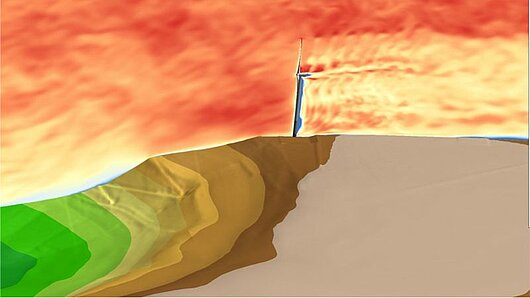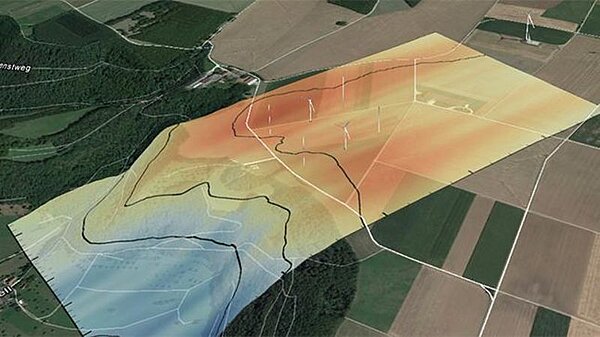High-Performance Computing Center Stuttgart

Despite this progress, Germany's largest energy needs are in the West and South of the country, where the population is larger and industry is more intensive. Although power companies have in recent years installed transmission wires to bring wind power from the North to these areas, many argue that generating wind power locally will be necessary to meet clean energy demands.
Doing so will be challenging, however, as the terrain in the South and West tends to be much more uneven than in the North. When the land is flat or a wind farm is mounted on the sea, engineers have good models for predicting how turbines will operate. However, if a planner wants to install a facility in complex topography, like that present in Southern Germany, he or she must contend with wind patterns that are irregular and non-uniform.
Existing models for such locations are not as reliable as those for simpler landscapes, while the rougher atmospheric conditions can be tough on existing wind turbine designs. These factors make it harder for planners to identify locations that could be effectively used for wind generation and to quantify energy yield and turbine loads.
To address this issue, the wind energy research cluster WindForS (www.windfors.de) launched a project in 2016 aimed at establishing a research site in the Swabian Jura, a chain of large hills located southeast of Stuttgart. The research facility will be the first in the world set in complex terrain where scientists will have full access to the turbine control and settings.
Among the team members are researchers in the University of Stuttgart's Institute for Aerodynamics and Gas Dynamics (IAG). Using HLRS's Hazel Hen supercomputer, the investigators performed detailed simulations that were important in choosing and planning the location for the test site and the specific locations of the turbines. And by providing computing power needed to model such complex systems, HLRS will play an ongoing role in supporting the project's future research.
The IAG team, led by Dr. Thorsten Lutz, uses numerical methods from computational fluid dynamics (CFD) to develop comprehensive models of the complex interactions between wind turbines and their surroundings. During planning of the forthcoming wind power test site, the WindForS cluster’s scientists integrated data including topographical maps, wind speed measurements, vegetation surveys, and geometrical and structural data of the wind turbines to develop an extremely detailed model of how it would function.

Once built, the test site will include two wind turbines as well as measurement towers, Lidar devices, and drones for documenting wind flow and turbulence. The wind turbines will also be embedded with extremely sensitive sensors to track mechanical loading and changes in shape that occur during operation. The data that the test site produces will enable the computational researchers from Stuttgart to validate and refine their models in ways that will improve understanding of the physics underlying wind power generation.
In practical terms, this unique research facility will address several key problems facing wind power generation in complex terrain.
One important focus will be on studying and reducing physical stress on wind turbines. The disturbed inflow of wind on hills can cause larger, more irregular vibrations that affect aerodynamic efficiency, while also raising loads and therefore the risk of damage to the turbine. Preventing this and ensuring that turbines have a longer lifespan is thus an important concern.
“Using simulation,” Lutz says, “we are helping to develop concepts for managing loads on the rotors and reducing vibrations.” This knowledge could not only improve durability but also increase efficiency in power generation.
In the future, the investigators also hope to improve understanding of aeroacoustic noise mechanisms and reducing the noise that can result from wind turbine operation.
Noise occurs as a result of interactions between wind and the rotor blades, when fluctuations in air pressure produce sound that is audible to the human ear. This disturbance can make it difficult to identify acceptable locations for wind turbines in densely populated areas. Lutz anticipates that the new test site will enable researchers to better understand how noise arises and to develop experiments with modified blades and rotor geometries capable of reducing it.
“In the future,” Lutz explains, “WindForS wants to create opportunities to test new technologies.” This could include, for example, trying out prototypes of new blade designs or investigating the effects of subtle changes in rotor shape.
WindForS also aims to be a partner for industrial and academic researchers. Once built, Lutz imagines that companies would be able to rent time at the facility to take measurements necessary for their development of new wind generation concepts.
For the simulation scientists involved in the project, the test site also offers the opportunity to test and refine their own CFD models. As new data accumulates and computing power increases at HLRS, it will be possible to develop increasingly precise simulations that will provide the foundational knowledge necessary for future technological improvements.
Most of the preparations have been completed for the test site and, pending a final environmental review, the scientists anticipate that construction will begin in 2019. Once operational, they hope that it will provide new insights that will expand opportunities for wind power generation not just in Germany, but across the world.
— Christopher Williams